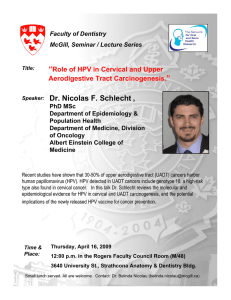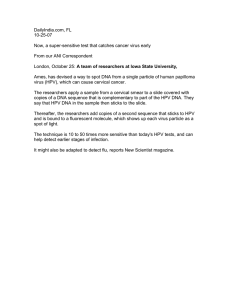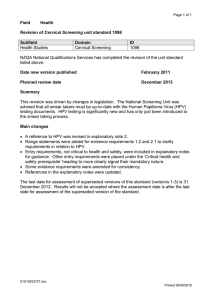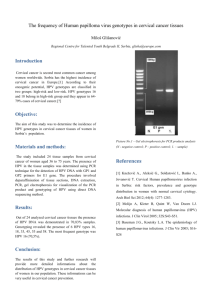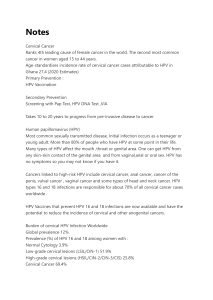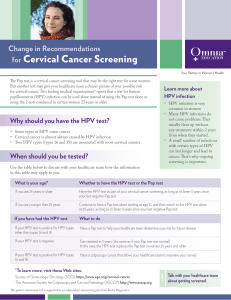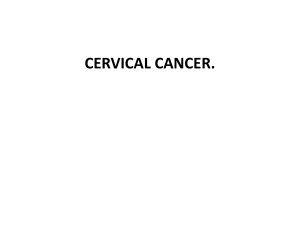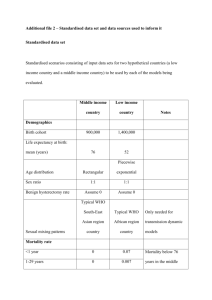Human Papillomavirus in the Latino/ Hispanic Community
advertisement
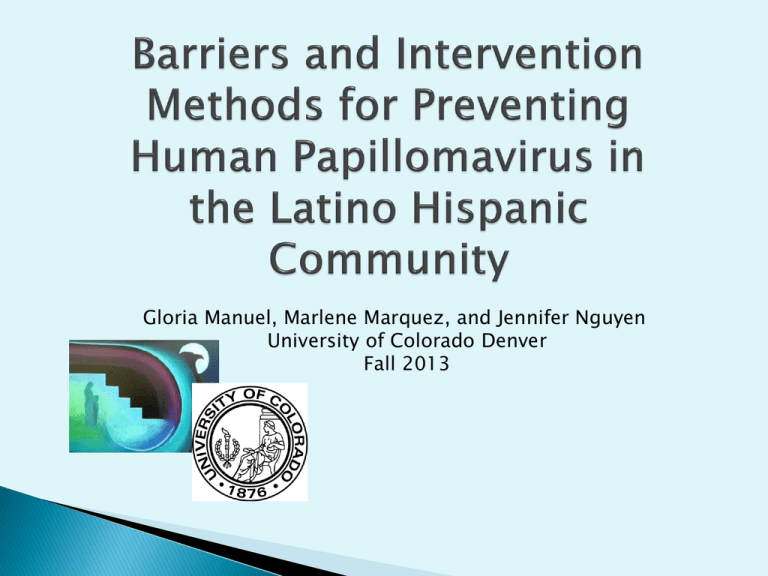
Gloria Manuel, Marlene Marquez, and Jennifer Nguyen University of Colorado Denver Fall 2013 HPV is the most common and most costly sexually transmitted disease worldwide Nearly all cervical cancers are caused by the Human papillomavirus (HPV) strains 16 & 18 ◦ About12,000 cervical cancer cases per year ◦ About 4,000 cervical cancer deaths per year (National Cancer Institute, SEER Data, 2013) Approximately 42.5% of U.S. women are infected with HPV at some point in their lives (American Cancer Society, 2012) 1999-2007 Annual Report to the Nation on the Status of Cancer, 1975-2009. (JNCI, 2012 ) HPV Vaccine Recommendations: ◦ ◦ ◦ ◦ Gardasil and Cervarix Females ages 11-26: 11-17 and 18-26 years old Males ages 11-21 3 doses over 6 months Reducing Behavioral Risks ◦ Regular use of condoms ◦ Limiting the number of partners (ACS, 2012) HPV Testing Recommendations ◦ Age 30 or older ◦ Abnormal Pap smears Cervical Cancer Screening Recommendations ◦ Beginning at age 21 ◦ Ages 21 to 29 - Pap test every 3 years ◦ Ages 30 to 65 - Pap test and HPV test every 5 years; OR a Pap test alone every 3 years. (ACS, 2012; CDC, 2013) HPV infection Diet Smoking Poverty Oral Contraceptives Family History (ACS, 2012) Healthy People 2020’s objective for cervical cancer is to reduce the mortality rate by 10% Baseline: 2.4 uterine cervix cancer deaths per 100,000 females occurred in 2007 (age adjusted to the year 200 standard population Target: 2.2 deaths per 100,000 females Target-Setting Method: 10 percent improvement Cost and Access to Care Cultural Beliefs/Language Lack of Knowledge/Literacy Misconceptions Psychological Factors Patient/Parents Factors/ Acceptance Parental consent/acceptance Barriers for parents Physicians/pediatricians beliefs and attitudes Addressing cost issue Education Engaging health care workers Culturally-tailored interventions Engage friends and family Empowering Latinas Discuss cost issue with patients Financial assistance (e.g., cover cost, co-pays) Work with the Vaccines for Children program Culturally tailored educational materials to increase HPV and vaccines knowledge ◦ Use different methods to educate Radionovelas Pamphlets in Spanish Magazines/Newspapers in Spanish Focus groups – both adolescents and parents Provide pediatricians with resources and trainings on how to approach parents Engaging health care workers ◦ Using Promotoras Culturally tailored interventions ◦ Address barriers to community (i.e. transportation problems), use community-based methods, include schools, churches, etc. Engaging friends and family ◦ Educating parents, peers, siblings ◦ Having informative sessions for parents-only Empowering women to advocate for themselves and their children NBCLatino.com HPV in boys and men Life of HPV vaccine Continue building culturally-tailored research and interventions for Latinas

